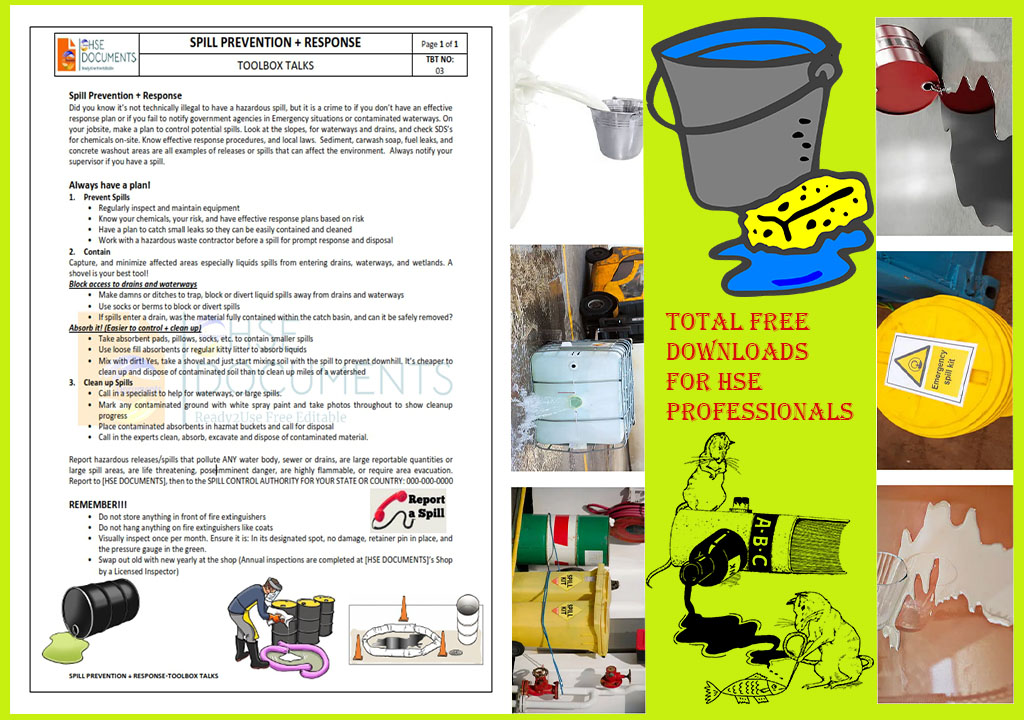 |
| SPILL PREVENTION AND RESPONSE DOCUMENTS |
TOOLBOX TALKS
Spill Prevention + Response
Did you know it’s not technically illegal to have a hazardous spill, but it is a crime if you don’t have an effective response plan or if you fail to notify government agencies in Emergency situations or contaminated waterways. On your job site, make a plan to control potential spills. Look at the slopes, for waterways and drains, and check SDSs for chemicals on-site. Know effective response procedures and local laws. Sediment, carwash soap, fuel leaks, and concrete washout areas are all examples of releases or spills that can affect the environment. Always notify your supervisor if you have a spill.
Always have a plan!
1. Prevent Spills
⦁ Regularly inspect and maintain equipment
⦁ Know your chemicals, and your risk, and have effective response plans based on risk
⦁ Have a plan to catch small leaks so they can be easily contained and cleaned
⦁ Work with a hazardous waste contractor before a spill for prompt response and disposal
2. Contain
Capture, and minimize affected areas, especially liquid spills from entering drains, waterways, and wetlands. A shovel is your best tool!
Block access to drains and waterways
⦁ Make damns or ditches to trap, block or divert liquid spills away from drains and waterways
⦁ Use socks or berms to block or divert spills
⦁ If spills enter a drain, is the material fully contained within the catch basin, and can it be safely removed?
Absorb it! (Easier to control + clean up)
⦁ Take absorbent pads, pillows, socks, etc. to contain smaller spills
⦁ Use loose fill absorbents or regular kitty litter to absorb liquids
⦁ Mix with dirt! Yes, take a shovel and just start mixing soil with the spill to prevent downhill. It’s cheaper to clean up and dispose of contaminated soil than to clean up miles of a watershed
3. Clean up Spills
⦁ Call in a specialist to help with waterways or large spills.
⦁ Mark any contaminated ground with white spray paint and take photos throughout to show cleanup progress
⦁ Place contaminated absorbents in hazmat buckets and call for disposal
⦁ Call in the experts to clean, absorb, excavate, and dispose of contaminated material.
Report hazardous releases/spills that pollute ANY water body, sewer, or drains, are large reportable quantities or large spill areas, are life-threatening, pose an imminent danger, are highly flammable, or require area evacuation. Report to [HSE DOCUMENTS], then to the SPILL CONTROL AUTHORITY FOR YOUR STATE OR COUNTRY: 000-000-0000
REMEMBER!!!
⦁ Do not store anything in front of fire extinguishers
⦁ Do not hang anything on fire extinguishers like coats
⦁ Visually inspect once per month. Ensure it is: In its designated spot, with no damage, the retainer pin is in place, and the pressure gauge is in the green.
⦁ Swap out old with new yearly at the shop (Annual inspections are completed at [HSE DOCUMENTS]’s Shop by a Licensed Inspector)






1.jpg)


No comments:
Post a Comment